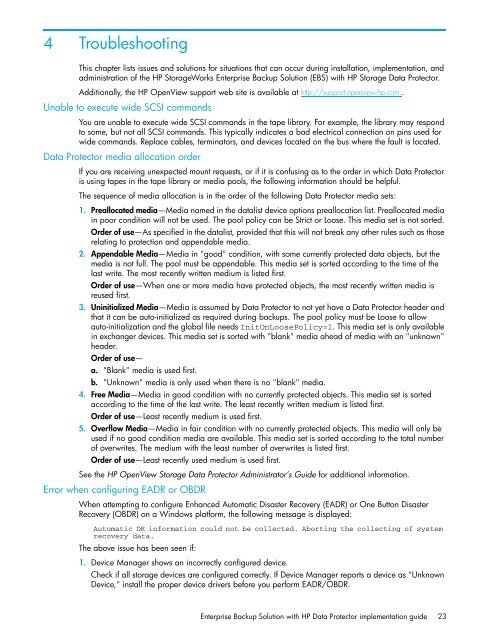HP StorageWorks Enterprise Backup Solution with HP Data ...
HP StorageWorks Enterprise Backup Solution with HP Data ...
HP StorageWorks Enterprise Backup Solution with HP Data ...
You also want an ePaper? Increase the reach of your titles
YUMPU automatically turns print PDFs into web optimized ePapers that Google loves.
4 Troubleshooting<br />
This chapter lists issues and solutions for situations that can occur during installation, implementation, and<br />
administration of the <strong>HP</strong> <strong>StorageWorks</strong> <strong>Enterprise</strong> <strong>Backup</strong> <strong>Solution</strong> (EBS) <strong>with</strong> <strong>HP</strong> Storage <strong>Data</strong> Protector.<br />
Additionally, the <strong>HP</strong> OpenView support web site is available at http://support.openview.hp.com..<br />
Unable to execute wide SCSI commands<br />
You are unable to execute wide SCSI commands in the tape library. For example, the library may respond<br />
to some, but not all SCSI commands. This typically indicates a bad electrical connection on pins used for<br />
wide commands. Replace cables, terminators, and devices located on the bus where the fault is located.<br />
<strong>Data</strong> Protector media allocation order<br />
If you are receiving unexpected mount requests, or if it is confusing as to the order in which <strong>Data</strong> Protector<br />
is using tapes in the tape library or media pools, the following information should be helpful.<br />
The sequence of media allocation is in the order of the following <strong>Data</strong> Protector media sets:<br />
1. Preallocated media—Media named in the datalist device options preallocation list. Preallocated media<br />
in poor condition will not be used. The pool policy can be Strict or Loose. This media set is not sorted.<br />
Order of use—As specified in the datalist, provided that this will not break any other rules such as those<br />
relating to protection and appendable media.<br />
2. Appendable Media—Media in "good" condition, <strong>with</strong> some currently protected data objects, but the<br />
media is not full. The pool must be appendable. This media set is sorted according to the time of the<br />
last write. The most recently written medium is listed first.<br />
Order of use—When one or more media have protected objects, the most recently written media is<br />
reused first.<br />
3. Uninitialized Media—Media is assumed by <strong>Data</strong> Protector to not yet have a <strong>Data</strong> Protector header and<br />
that it can be auto-initialized as required during backups. The pool policy must be Loose to allow<br />
auto-initialization and the global file needs InitOnLoosePolicy=1. This media set is only available<br />
in exchanger devices. This media set is sorted <strong>with</strong> "blank" media ahead of media <strong>with</strong> an "unknown"<br />
header.<br />
Order of use—<br />
a. "Blank" media is used first.<br />
b. "Unknown" media is only used when there is no "blank" media.<br />
4. Free Media—Media in good condition <strong>with</strong> no currently protected objects. This media set is sorted<br />
according to the time of the last write. The least recently written medium is listed first.<br />
Order of use—Least recently medium is used first.<br />
5. Overflow Media—Media in fair condition <strong>with</strong> no currently protected objects. This media will only be<br />
used if no good condition media are available. This media set is sorted according to the total number<br />
of overwrites. The medium <strong>with</strong> the least number of overwrites is listed first.<br />
Order of use—Least recently used medium is used first.<br />
See the <strong>HP</strong> OpenView Storage <strong>Data</strong> Protector Administrator’s Guide for additional information.<br />
Error when configuring EADR or OBDR<br />
When attempting to configure Enhanced Automatic Disaster Recovery (EADR) or One Button Disaster<br />
Recovery (OBDR) on a Windows platform, the following message is displayed:<br />
Automatic DR information could not be collected. Aborting the collecting of system<br />
recovery data.<br />
The above issue has been seen if:<br />
1. Device Manager shows an incorrectly configured device.<br />
Check if all storage devices are configured correctly. If Device Manager reports a device as "Unknown<br />
Device," install the proper device drivers before you perform EADR/OBDR.<br />
<strong>Enterprise</strong> <strong>Backup</strong> <strong>Solution</strong> <strong>with</strong> <strong>HP</strong> <strong>Data</strong> Protector implementation guide 23

















